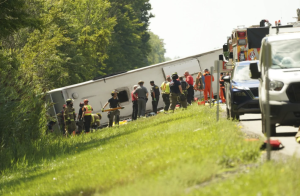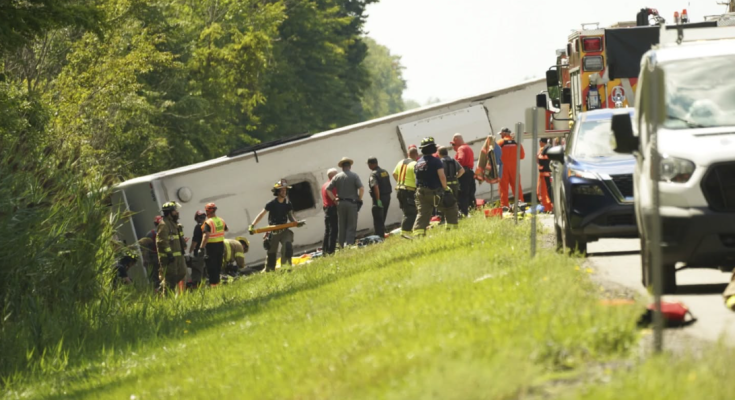Niagara Falls Tour Bus Crash: Multiple Dead, Dozens Injured
On what was meant to be a joyful excursion to one of the world’s most iconic natural wonders, tragedy struck when a tour bus carrying dozens of passengers crashed near Niagara Falls, leaving multiple people dead and many others injured. The shocking incident has shaken not only the local community but also the broader tourism industry, as authorities scramble to understand how such a devastating accident could have happened.
A Day That Began With Excitement
The passengers on board were mostly tourists—families, retirees, and groups of friends—eager to experience the breathtaking views of Niagara Falls. For many, it was their first time visiting. They boarded the large coach bus early in the morning, chatting, snapping pictures, and making plans for the day ahead. The air was filled with anticipation, the kind that comes with a trip to a world-famous landmark.
But that excitement would tragically transform into chaos and terror.
The Crash
According to preliminary reports from local authorities, the accident occurred on a stretch of highway just a few miles from Niagara Falls State Park. Witnesses described the bus swerving abruptly before veering off the road. It careened down an embankment, striking a guardrail, before rolling onto its side.
The sound of metal scraping against concrete echoed across the highway. Shards of glass sprayed across the road, and the cries of terrified passengers filled the air. Some were pinned inside the bus, while others were thrown from their seats by the force of the impact.
“We heard this horrible screeching sound, and then it was like an explosion,” recalled one driver who had been following behind. “The bus just lost control. It was terrifying to watch.”
Emergency Response
Within minutes, first responders rushed to the scene. Police, firefighters, and paramedics worked frantically to pull survivors from the wreckage. Several passengers were trapped inside, requiring heavy rescue equipment to cut through twisted metal and free them.
Helicopters were dispatched to airlift the most critically injured victims to nearby hospitals, while ambulances transported others with broken bones, head injuries, and deep lacerations. For many first responders, it was one of the most harrowing scenes they had encountered in years.
Officials later confirmed multiple fatalities at the scene. The exact number has not yet been finalized as the investigation continues, but dozens of others remain hospitalized—some in critical condition.
Families Torn Apart
Among the victims were couples on vacation, parents traveling with young children, and elderly tourists who had long dreamed of seeing Niagara Falls. For some families, the trip ended in unbearable grief.
One woman who had been traveling with her parents tearfully told reporters, “We were just talking about how beautiful the falls would look this time of year. The next thing I knew, everything went black, and I woke up in the hospital. My parents… they didn’t make it.”
The heartbreak has rippled across communities far beyond Niagara, as loved ones back home receive the devastating news.
Investigating the Cause
Authorities have launched a full-scale investigation to determine what caused the crash. Early reports suggest that weather may not have been a factor, as skies were clear at the time of the accident. Instead, investigators are focusing on mechanical issues, driver fatigue, or possible medical emergencies that could have led to the bus losing control.
The bus company, whose name has not yet been publicly released, is cooperating with investigators. Records are being examined to determine whether the bus had undergone proper maintenance and whether the driver had complied with safety regulations, including mandatory rest periods.
The National Transportation Safety Board (NTSB) has also dispatched a team of experts to assist in piecing together the chain of events.
Shockwaves Through the Tourism Industry
Niagara Falls attracts millions of visitors each year, and bus tours are among the most popular ways to reach the site. The crash has cast a shadow over the region’s tourism industry, raising concerns about the safety of large-scale group travel.
Local businesses, many of which rely heavily on tourism, expressed both grief and solidarity. Hotels offered emergency lodging for stranded passengers, while restaurants prepared food for families waiting outside hospitals.
“We welcome visitors from all over the world,” one local official said, “but today our hearts are heavy. Niagara Falls is supposed to be a place of joy and wonder, not tragedy.”
Survivors’ Stories
Amid the heartbreak, stories of bravery and resilience are emerging. Several passengers helped pull others from the wreckage despite their own injuries. One off-duty nurse who was on the bus immediately began administering first aid, using whatever she could find to stop bleeding and keep victims stable until paramedics arrived.
Another survivor, still shaken and wrapped in a hospital blanket, told reporters: “It felt like the world flipped upside down. But strangers became family in that moment—we held each other’s hands, prayed together, and tried to stay alive.”
Community Mourning
Vigils have already been planned near Niagara Falls for the victims. Local churches and community centers are offering counseling services for survivors and grieving families. Flags in the area were lowered to half-staff, and a moment of silence is expected at upcoming public events.
Social media has been flooded with messages of support and grief, with many sharing their own memories of visiting Niagara Falls and expressing solidarity with the victims.
Calls for Reform
The tragedy has sparked renewed calls for stricter safety regulations in the tour bus industry. Advocates argue that too many buses are operating with insufficient oversight, putting passengers at risk. Proposals include more frequent inspections, mandatory installation of seat belts, and stricter limits on how long drivers can remain behind the wheel without rest.
Lawmakers have already indicated that hearings may be scheduled to address concerns about passenger safety on chartered tour buses.
Looking Ahead
For now, the focus remains on caring for the injured and comforting the grieving. Hospitals in the region are stretched thin but determined to provide the best care possible. Blood donation centers have seen an influx of volunteers, and local residents have rallied to provide meals, blankets, and shelter to those affected.
The road to healing will be long. Survivors must cope not only with physical injuries but also with the trauma of what they experienced. Families who lost loved ones will face the painful process of funerals, memorials, and unanswered questions.
Yet, amid the sorrow, the human spirit endures. The resilience of survivors, the dedication of first responders, and the compassion of the community offer a glimmer of hope that even in the face of tragedy, unity and kindness prevail.
Conclusion
The Niagara Falls tour bus crash is a stark reminder of how quickly life can change. A day that began with joy and anticipation ended in devastation, leaving families shattered and a community in mourning. As investigations continue and reforms are considered, the memory of those lost will not be forgotten.
Niagara Falls has always symbolized nature’s power and beauty. Today, it also stands as a backdrop to human fragility—and the enduring strength of those who survive, grieve, and rebuild.


